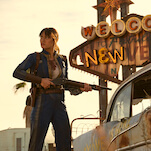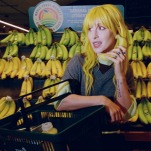Top Chef: "Restaurant Wars"

There are a lot of things to like about the “Restaurant Wars” episode every season: The chefs not only have to conceive of a restaurant (the name, the type of cuisine, the menu) and set up the front of the house, but they also have to perform together as they would in a real kitchen, when food has to go out in a timely, coordinated fashion. I’ve never been much of a fan of the front-of-the-house tasks—to mangle an oft-repeated phrase on the show, this is Top Chef, not Top [Host]. And the notion of decorating a space in 24 hours is absurd even in the reality-show pretend world; the restaurants generally looks like hastily draped Off Off Broadway theater sets.
But mostly, I like “Restaurant Wars” because it represents the tipping point of every season, when the crowded, chaff-filled early weeks end, the stakes are raised, and the real competition commences. It brings some much-needed clarity: For one, the chefs themselves make it painfully obvious who they do and don’t respect as competition, and if that weren’t enough, the process of performing an actual food service draws out their strengths and weaknesses. By the end, the oddsmakers among us have a much better idea of who’s sticking around for the finale, and a general sense of how the season is shaping up overall. On the latter point, I’ve come to this conclusion: A year after its best season, where four very strong and memorable chefs all had a legitimate chance to take the title, Season Seven is easily one of the weakest in the show’s entire run, if not the worst outright. Uninspired cooking, blah personalities, and a formula that isn’t getting any fresher.
Nevertheless, the producers do have the smarts to pick the right challenges to repeat. The “Tag-Team Cook-off” Quickfire was only devised last season, but it was an instant classic, and a great way to establish continuity between the Quickfire and the “Restaurant Wars” Elimination challenge, since the teams stay the same. Here, the knife-drawing left Ed and Kevin to pick their teams and like the cruel playground ritual that it is, we know who they consider the gawky nerds with coke-bottle glasses. Amanda and Alex are last picked, but it’s really Alex who seems widely considered the most toxic asset, for being sloppy and weird and a general flibbertigibbet. Since the Tag-Team format requires a cohesive transition from one 10-minute cooking session to the next, having one weak link is especially troublesome. Unlike “Restaurant Wars,” you can’t take over or push the dunce to the front of the house.
And lo, Alex screws up the second leg by seasoning the red snapper two steps too early. His Red Team chums (Tiffany, Angelo, and Ed) are not the most communicative bunch anyway, but all of them are baffled by the gaffe yet powerless to keep it from tripping them up. Angelo does his best to curb the seasoning imbalance, but ultimately you can’t take salt away from an oversalted dish. The Blue Team (Kevin, Kenny, Kelly, Amanda), in contrast, executes the Quickfire perfectly by having each chef leave clues to the next one about what they’re making and what steps need to be taken. In essence, it’s really a team-building exercise, and thus the ideal lead-in to Restaurant Wars.
From a production standpoint, I was happy this year’s incarnation of Restaurant Wars deemphasized the design element of the restaurant space. Evoo and 2121 didn’t look all that different from one another, which meant the front-of-the-house responsibilities had more to do with the practicalities of coordinating service than playing dress-up. As for the action in the kitchen, we were set up to believe that the Red Team—harried, short-tempered, saddled with Alex—was going to crumble to the confident, well-organized Blue Team like they did in the Quickfire. Certainly, Kenny, who’s been nothing if not confident throughout his run on the show, felt they were a virtual lock.












![HBO teases new Euphoria, Larry David, and much more in 2026 sizzle reel [Updated]](https://img.pastemagazine.com/wp-content/avuploads/2025/12/12100344/MixCollage-12-Dec-2025-09-56-AM-9137.jpg)



























